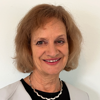Our Chair of Trustees, Heather Giles, shares her thoughts on ARVO 2025, an annual conference that brings together vision scientists from all stages of their career.
Imagine 10,000 ophthalmic researchers, clinicians and scientists all gathered, presenting new data, planning future work, sharing the excitement of new discoveries on the march towards treating, preventing and managing sight loss. That was ARVO 2025 in Salt Lake City, Utah.
There were 16-20 simultaneous sessions and more than 200 posters every day, as well as an exhibition hall with several hundred booths. Fight for Sight funded research, and researchers were well-represented. Fight for Sight’s Programme Manager, Steven Smith, and I heard the latest results from many of those we are funding, at posters and oral presentation sessions.
We saw capacity building in action, and received huge thanks from scientists whose career had started with a grant from us, enabling them to get grants from other funding sources, and to set up their own lab. This has allowed them to be fully committed to a career in eye research. We are so lucky to have the support of so many senior figures in the sector who were active in the meeting, chairing symposia, presenting key lectures and moderating poster sessions.
Myopia (near-sightedness) was a key theme of the meeting. Chris Hammond, Fight for Sight trustee and Chair of our Grants and Impact committee, chaired one of several symposia on this topic. Did you know that myopia is considered an epidemic in the UK, particularly among young people?
The prevalence of myopia continues to increase, and a significant number have progressively worsening myopia which can lead to blinding eye diseases in adult life. Understanding why this happens, and how to prevent it, is a critical area of research. Interestingly, some simple childhood interventions, such as reduced screen time, and at least two hours in outside daylight may help reduce the rate of increase in the length of the eye – the root cause of most myopia. However, understanding the basic mechanisms, and identifying effective interventions, is key to halting this epidemic.
Our ageing population is also contributing to the increase in those with visual impairment. A session on dual sensory impairment provided the alarming statistic that, by age 80, 1 in 4 people will have both a visual and hearing impairment, with a resulting huge increase in loneliness and isolation. Furthermore, we know that these circumstances are associated with an increase in dementia. The researchers made the interesting argument that, if we could correct or slow vision loss, we would also contribute to tackling the wave of dementia in our elderly population.
The use of Artificial Intelligence (AI) was a constant thread throughout the conference. It’s being used for genetic analyses, robotic surgery, eye injections, on mobile phones for reminders and instructions, and much more. AI is particularly useful to manage and interpret large volumes of data (big data), such as the digital images required for the diagnosis of most eye diseases: these currently require interpretation by an ophthalmologist. The promise of AI is that large databases of images from normal and diseased eyes can be used to develop computer algorithms which can rapidly and accurately diagnose disease.
However, much work remains to be done before this becomes a large-scale reality in ophthalmology. The large data sets required to train the computer must be available, of high quality, from similar imaging machines, and from diverse populations representative of those who will be screened, and free from bias. In addition, the AI system must be validated and approved by regulatory authorities prior to becoming widely available for patients. Finally, patient involvement in the development of AI is sadly lacking. There is much work to do before the promise of AI to facilitate and improve diagnosis and treatment becomes fully realised.
In short, ARVO was inspirational, and highly successful in accomplishing what is the huge value of these meetings: the chance to exchange ideas, make plans and brainstorm with highly-regarded people in our field. I left the meeting in no doubt that our work at Fight for Sight is most certainly having an impact, not just in the UK, but in the global effort to save sight and change lives of all those with visual impairment.

"I left the meeting in no doubt that our work at Fight for Sight is most certainly having an impact, not just in the UK, but in the global effort to save sight and change lives."
Stay in the loop
on eye research breakthroughs, inspiring real life stories and more...

Latest from our research blog

Related content





